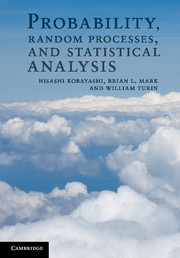 Probability, Random Processes, and Statistical Analysis
Probability, Random Processes, and Statistical Analysis from Part V - Applications and advanced topics
Published online by Cambridge University Press: 05 June 2012
Introduction
In this chapter we shall discuss hidden Markov models (HMMs), which have been widely applied to a broad range of science and engineering problems, including speech recognition, decoding and channel modeling in digital communications, computational biology (e.g., DNA and protein sequencing), and modeling of communication networks.
In an ordinary Markov model, transitions between the states characterize the dynamics of a system in question, and we implicitly assume that a sequence of states can be directly observed, and the observer may even know the structure and parameters of the Markov model. In some fields, such as speech recognition and network traffic modeling, it is useful to remove these restrictive assumptions and construct a model in which the observable output is a probabilistic function of the underlying Markov state. Such a model is referred to as an HMM.
We shall address the important problems of state and parameter estimation associated with an HMM: What is the likelihood that an observed data is generated from this model? How can we infer the most likely state or sequence of states, given a particular observed output? Given observed data, how can we estimate the most likely value of the model parameters, i.e., their MLEs? We will present in a cohesive manner a series of computational algorithms for state and parameter estimation, including the forward and backward recursion algorithms, the Viterbi algorithm, the BCJR algorithm, and the Baum–Welch algorithm, which is a special case of the EM algorithm discussed in Section 19.2.
To save this book to your Kindle, first ensure [email protected] is added to your Approved Personal Document E-mail List under your Personal Document Settings on the Manage Your Content and Devices page of your Amazon account. Then enter the ‘name’ part of your Kindle email address below. Find out more about saving to your Kindle.
Note you can select to save to either the @free.kindle.com or @kindle.com variations. ‘@free.kindle.com’ emails are free but can only be saved to your device when it is connected to wi-fi. ‘@kindle.com’ emails can be delivered even when you are not connected to wi-fi, but note that service fees apply.
Find out more about the Kindle Personal Document Service.
To save content items to your account, please confirm that you agree to abide by our usage policies. If this is the first time you use this feature, you will be asked to authorise Cambridge Core to connect with your account. Find out more about saving content to Dropbox.
To save content items to your account, please confirm that you agree to abide by our usage policies. If this is the first time you use this feature, you will be asked to authorise Cambridge Core to connect with your account. Find out more about saving content to Google Drive.